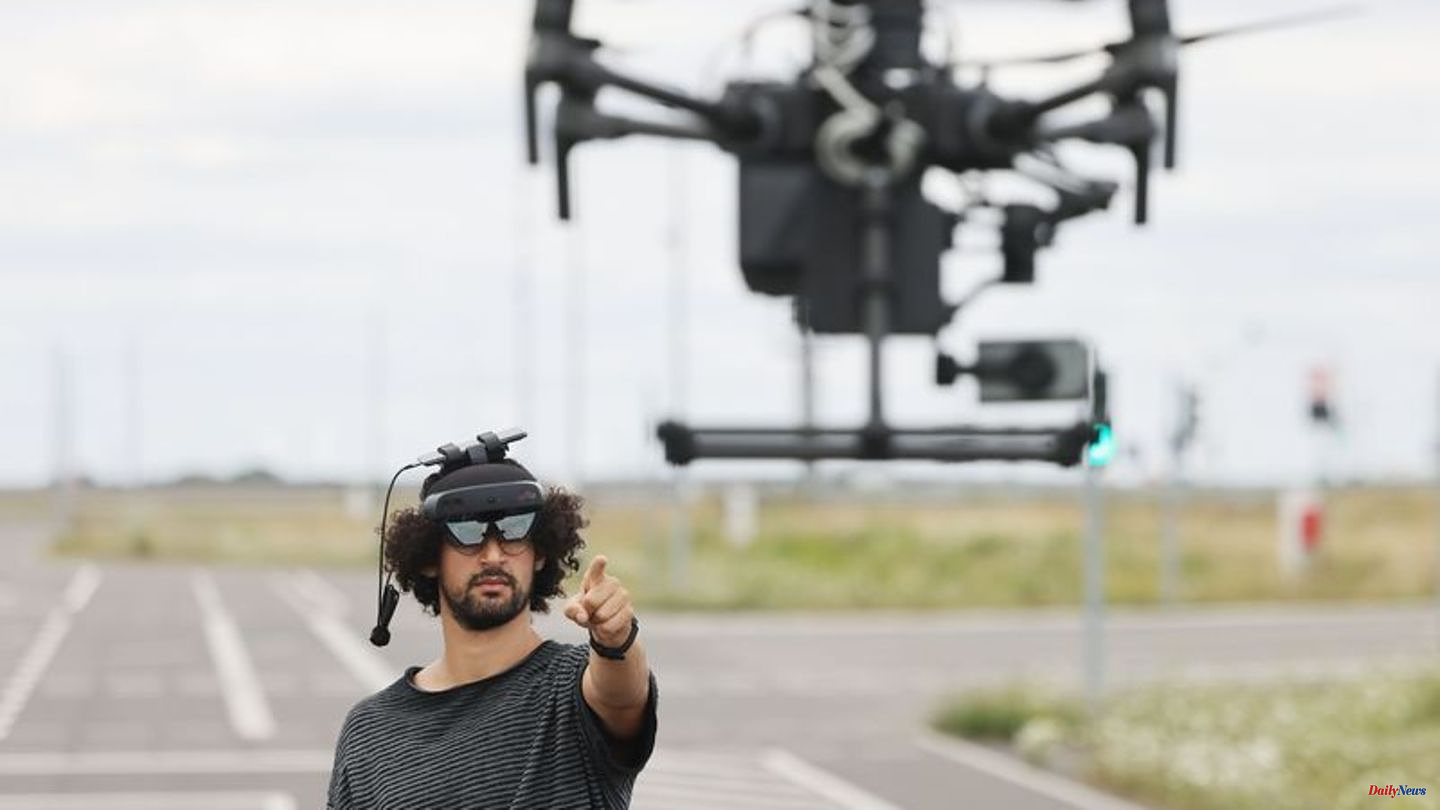A finger pointing forward, a gesture upwards and then the palm of the hand is tapped with a finger: It looks strange how the Vodafone developer Mohamed Azzahhafi is standing outdoors in a test center in Aldenhoven near Aachen (NRW) and his hands back and forth emotional. Not far from him you can see the reason for the gesture in the air: a drone. The 29-year-old wears a "Hololens" - glasses that allow the user to look at a digital screen. The pilot controls the five-kilo drone with finger movements and the HoloLens, which recognizes the movements as commands. He doesn't have a controller.
Gesture control is intended to simplify drone operation, also because the necessary movements are easier to learn and more intuitive than operating a controller. The digital field that Azzahhafi sees in front of him thanks to HoloLens has advantages. In this way, he can locate the drone on a map in no time at all. Even if the drone disappears into a cloud, it knows exactly where it is. Thanks to 5G, the pilot's field of vision is digitally expanded to a certain extent.
The fact that this futuristic-looking project is going well so far is also due to a nearby cell phone mast. It transmits signals in the 5G radio standard. "There is real-time communication between the drone and the pilot, which enables safe control even from a great distance," says Azzahhafi. This would not be possible with the previous standard 4G and with WLAN signals, with which many drones are connected.
Strict rules for flights out of sight
So far, privately operated drones have usually only been allowed to fly within the range of vision. That means the pilot must be able to see the missile from the ground. The advantages of 5G should now be a strong argument for changing the rules and being allowed to extend the range. According to Vodafone, the pilot is always well informed because of the mobile phone standard. "An almost limitless flight would be possible, but not allowed," says developer Azzahhafi.
Flights beyond the line of sight are already possible under certain conditions. But this requires a risk assessment and an operating permit, and the regulations are strict. Which is understandable given the security issues.
A big step towards increased use of drones could come in 2023 based on EU regulations. Then drone airspaces could be defined in which unmanned air traffic would also be easier to carry out of sight. In such airspaces, the positions of all road users would be recorded and exchanged with each other. 5G could also be important for this. To a certain extent, the mobile radio standard should be a key to significantly expanding the possible uses of drones.
Seamless connection must be guaranteed
Achim Friedl from the Association for Unmanned Aviation (UAV DACH) is cautious. "5G has great advantages, but there are still some questions to be answered for commercial use in drone flights." The radio signal becomes weaker at higher altitudes - the airspace is not "illuminated" enough everywhere. He emphasizes: "A seamless mobile phone connection must be guaranteed so that a pilot can always steer and, for example, avoid a collision with another flying object." Official approvals for commercial flight operations would only be granted once this guarantee had been demonstrated for the intended flight area.
Vodafone's competitors have also recognized the 5G potential. According to Telefónica Deutschland, 5G-controlled drones can be used to implement new applications in the industrial sector and optimize processes for business customers. "Outdoor facilities that are difficult to access such as power poles, bridges, power plants or ports can be monitored even faster and more efficiently using 5G-controlled drones and our o2 5G network," says Chief Technology Officer Mallik Rao.
So far, 5G has played a role in drone operations, especially in so-called campus networks. These are demarcated areas where a company or other organization is digitally protected and has very powerful connections. At the Port of Hamburg, drones are on the move in Telekom's 5G campus network. And industrial companies use drones on their factory premises for supporting functions.
Traffic management aims to prevent collisions
The Vodafone example from Aldenhoven now shows that more is possible beyond the campus networks. 5G drone flights could also help in the event of floods or forest fires, Vodafone praises further advantages in order to transmit recordings during the flight. One catch is that not all corners of Germany have 5G reception. But the expansion is in full swing.
Ralph Schepp, Managing Director at Droniq, also thinks big about 5G. Among other things, the company offers a traffic management system that shows drone pilots the positions of other missiles in real time and is intended to prevent collisions. The company, almost half of which is owned by Telekom, uses the mobile network of the Bonn group - partly 4G, partly 5G.
Schepp explains that the 4G mobile communications standard is still sufficient for certain applications, such as the digital localization of drones. "But when it comes to real-time connections and the simultaneous transmission of larger amounts of data, you need 5G." As an example, he cites bridge inspections or control flights on gas pipelines - thanks to 5G, drone recordings of these could be transmitted and evaluated during the flight. "Enormous bandwidths are required, which are not a problem for 5G."
Christian Müller from the European Helicopter Association calls the 5G potential for drones "enormous" - the radio standard has "the potential to enable all participants in the airspace to have additional capabilities". However, he also has subtle concerns and points out "the influence of 5G waves on certain instruments in aircraft in civil aviation". This is an issue above all in the USA, in Europe the frequency bands are far enough apart. In the future, however, this could also become an issue here, "if the frequency bands are expanded so that more data can be transmitted".












